A neck massage is focused on the muscles around the neck and shoulder area. Some muscles worked on during a neck massage include the sternocleidomastoid, scalenes and upper trapezius. A neck massage aims to relieve tension, reduce headaches and increase relaxation. Many techniques are used to achieve a range of benefits by increasing muscle temperature to help improve tissue elasticity and reduce joint stiffness. Our massage therapists at Physio.co.uk use neck massage to help reduce pain, increase range of movement and decrease muscle tightness.
What techniques are used in a neck massage?
A wide range of techniques can be used during a neck massage. The techniques most commonly used include:
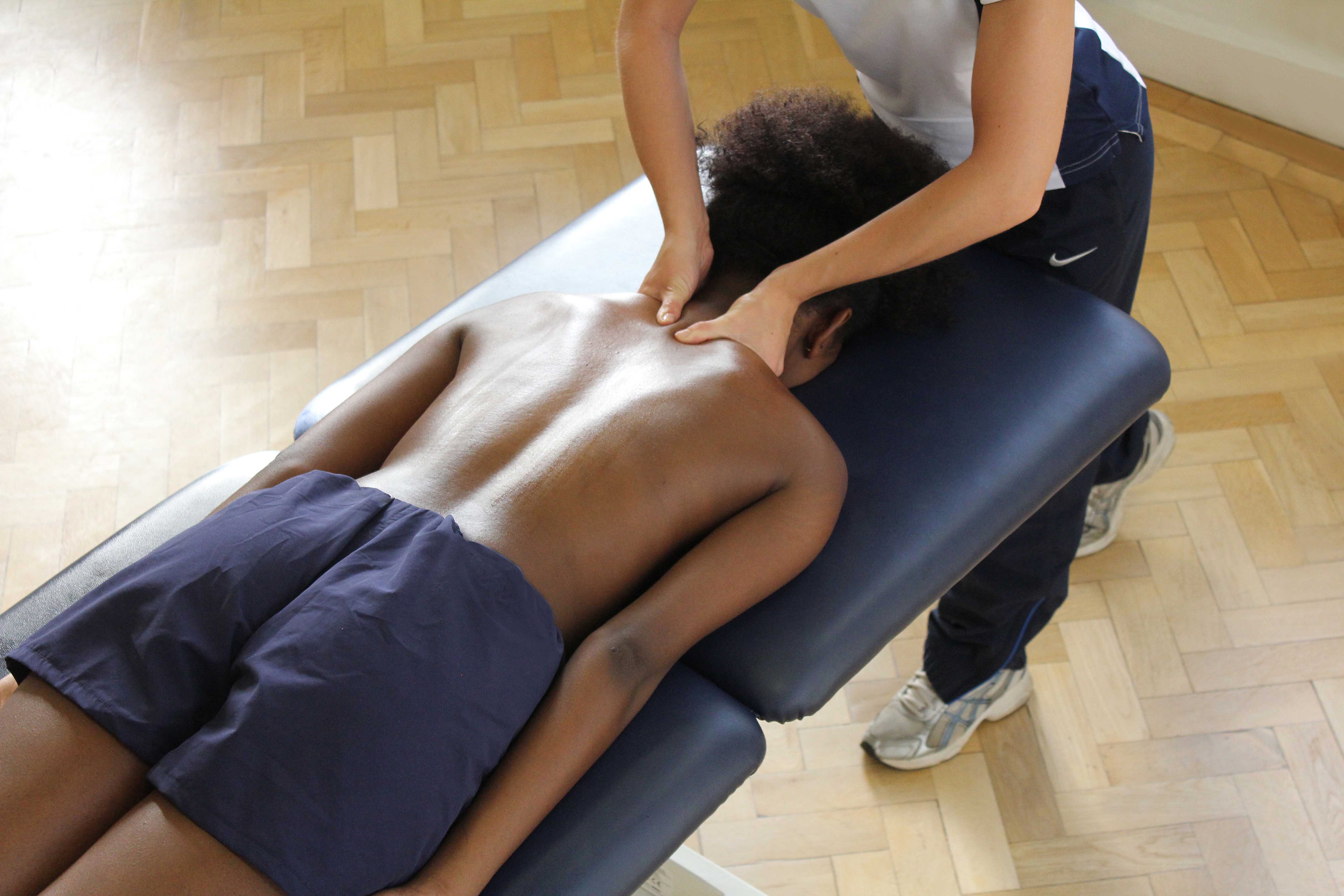 Above: Deep tissue massage of neck focusing on the trapezius muscles
Above: Deep tissue massage of neck focusing on the trapezius musclesThe most common techniques used during a neck massage include acupressure, mobilisations and skin rolling.
Acupressure is often used during a neck massage. Acupressure involves applying pressure to specific areas of the neck using the fingers and thumbs. Acupressure is commonly used to help break down muscular knots and increase blood flow. An ischemic reaction occurs when performing acupressure due to restricted blood flow as pressure is applied. The pressure applied encourages muscles fibres to relax allowing muscular knots to soften and break down. The softening and breaking down of muscular knots helps to reduce pain within the neck area. As the pressure is released, blood flow to the area increases, providing an increase in oxygen and nutrients to the muscles allowing an increase in healing.
Mobilisations are an effective technique used during a neck massage. Mobilisations involve applying pressure to the spinous and transverse processes located on the vertebrae of the cervical spine. As pressure is slowly added and released simultaneously to the processes, each joint between the vertebrae become looser and more "lubricated" allowing an increase of movement. Mobilisations are useful to reduce joint stiffness. Reducing joint stiffness also helps to reduce tension built up due to a lack of movement within the muscles surrounding the spine. Reducing joint stiffness and muscular tension help to increase flexibility and relieve pain.
Skin rolling is regularly used during a neck massage. Skin rolling is where fingers and thumbs are used to pick up and roll skin. Skin rolling is effectively used to reduce restriction created by fascia, a tough layer of connective tissues beneath the skin surface, as well as increase blood flow. Fascia often becomes restrictive due to muscle tightness, injury, surgery or pain and can further decrease movement and flexibility. An increase in blood flow caused by skin rolling is used to rise the temperature of fascia, allowing it to loosen and stretch. Loosened fascia as a result of skin rolling therefore enables movement to increase due to a decrease in restriction.

When can a neck massage help?
There are various situations a neck massage can help. The situations most often helped through neck massage include:
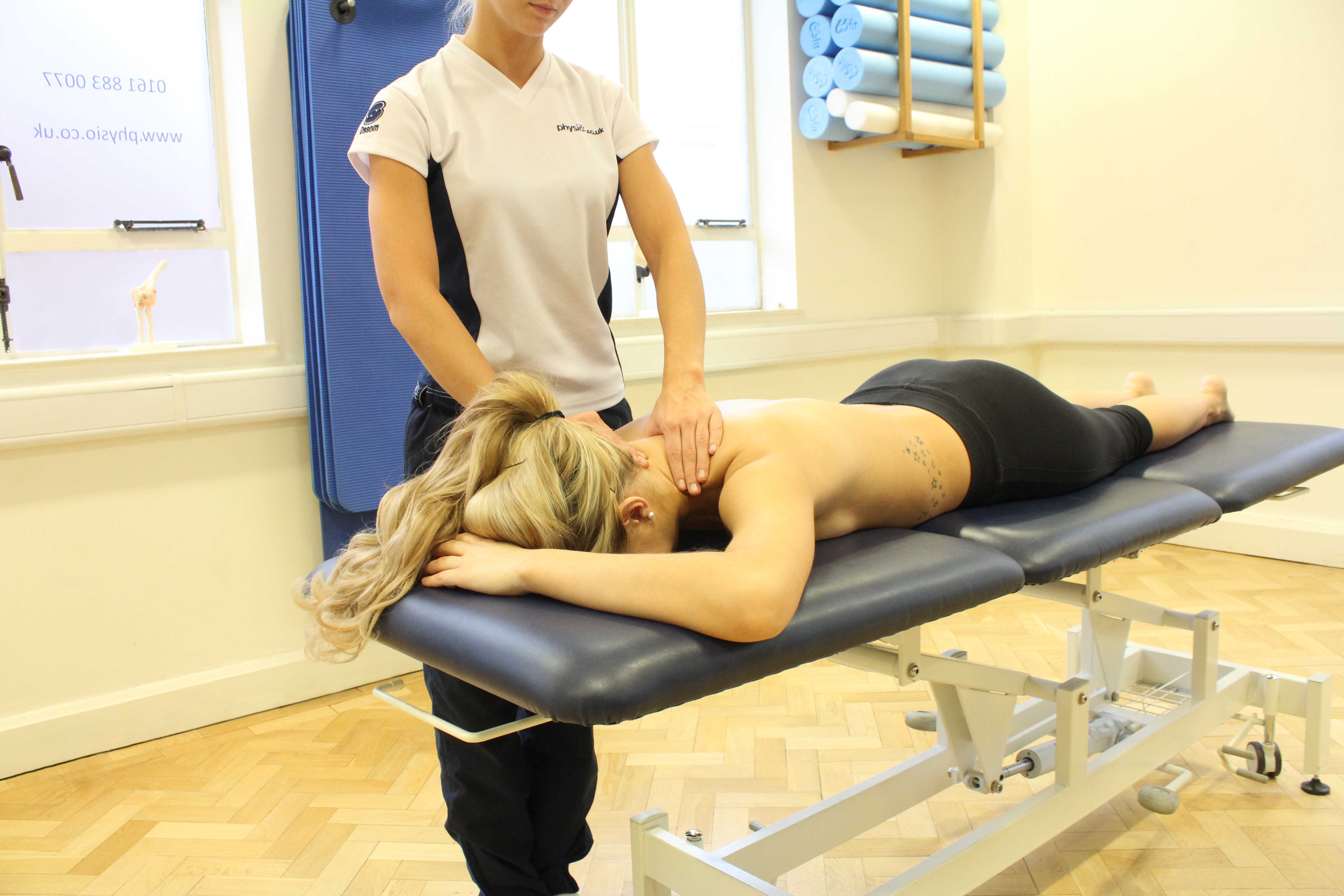 Above: Soft tissue massge of the neck including semi spinalis capitis and trapezius muscles
Above: Soft tissue massge of the neck including semi spinalis capitis and trapezius musclesHow does a neck massage help acute pain?
Acute pain can be reduced through neck massage. Acute pain can be a result of injury, surgery, muscle tension or muscle overuse. When an area of the body is damaged, pain receptors in the skin send a signal to the brain where the message is then passed to the nerves to create a feeling of pain.
A neck massage concentrates on reducing pain by relieving tension and disturbing the signal sent to the brain.
Tension within muscles can cause an increase in acute pain. Tension can be caused by muscle overuse, injury or poor posture. A build-up of tension can result in an increase in muscular knots or trigger points. Trigger points cause an increase in pain in a specific area unless it compresses a nerve. When a trigger point compresses a nerve, referred pain can occur causing an increase in shooting pains down the nerves pathway. Tension is relieved by an increase in muscle temperature. An increase in muscle temperature improves tissue elasticity. An increase in tissue elasticity allows muscles to relax and tension to decrease. Decreasing tension prevents trigger points from forming and reduces acute pain.
A neck massage can often disturb the signal sent from the skin receptors to the brain that damage has occurred to the body. Friction is created between the skin and fingers during a neck massage creating a new sensation for the skin receptors. When a new sensation is detected, a new signal is sent to the brain, disturbing the old message of damage. A new signal sent to the brain means the nerves do not receive the message to create feelings of pain and instead create feelings of relaxation. Increasing feelings of relaxation therefore reduce acute pain.
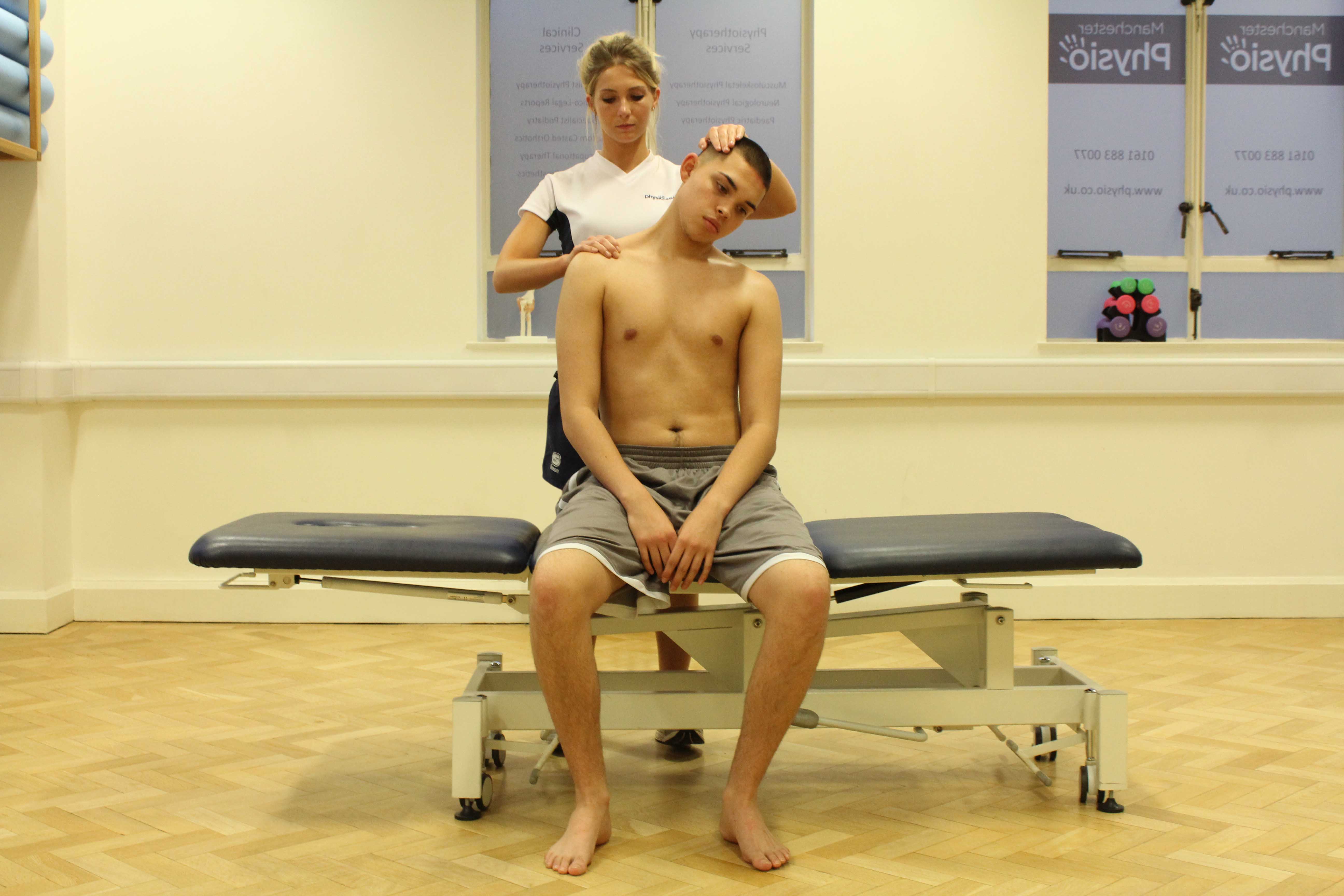 Above: Active stretch applied to trapezius muscle
Above: Active stretch applied to trapezius muscleHow does a neck massage help relaxation?
A neck massage is commonly used to increase relaxation. Relaxation can occur both physically and mentally within a person. Physical relaxation is linked with the musculoskeletal system whereas mental relaxation involves hormones" negative and positive levels.
A neck massage can increase relaxation by relieving pain and increasing positive hormones.
Pain can be caused by injury, muscular fatigue and muscle overuse. A neck massage reduces pain by encouraging an increase in blood flow. Blood flow is increased as a result of friction created between the skin and fingers. Blood flow is used to both increase muscle temperature and supply muscles with an increase in oxygen and nutrients. An increase in muscle temperature allows muscle fibres to relax and loosen, relieving muscle tightness and tension. An increase in the supply of oxygen and nutrients allows an increase in healing and helps to maintain the health and strength of muscles. Relieving tightness and tension as well as increasing healing helps to relieve pain, increasing physical relaxation.
A neck massage promotes the release of positive hormones such as serotonin, dopamine and endorphins. Positive hormones are responsible for giving a person a sense of well-being, reducing stress and increasing relaxation. A lack of positive hormones means stress and anxiety levels can often increase resulting in poor mental relaxation. The promotion of an increase in positive hormones reduces or prevents an increase in stress and anxiety therefore increasing mental relaxation.
How does a neck massage help tight muscles?
A neck massage is an effective treatment for the relief of muscle tightness. Muscle tightness is common in a range of people and is most often caused by poor posture, injury or muscle overuse.
A neck massage aims to reduce muscle tightness by reducing tissue inelasticity.
A neck massage encourages an increase in blood flow due to the creation of friction. As blood flow increases, muscle temperature rises. A rise in muscle temperature loosens muscles fibres, enabling them to relax. Relaxed muscle fibres improve tissue elasticity and allows a muscle to stretch to its full length. When muscles are able to stretch to their full length with no restriction or pain, muscle tightness has been reduced.
What are the benefits of a neck massage?
A variety of benefits can often be gained through neck massage. The benefits most commonly gained include:
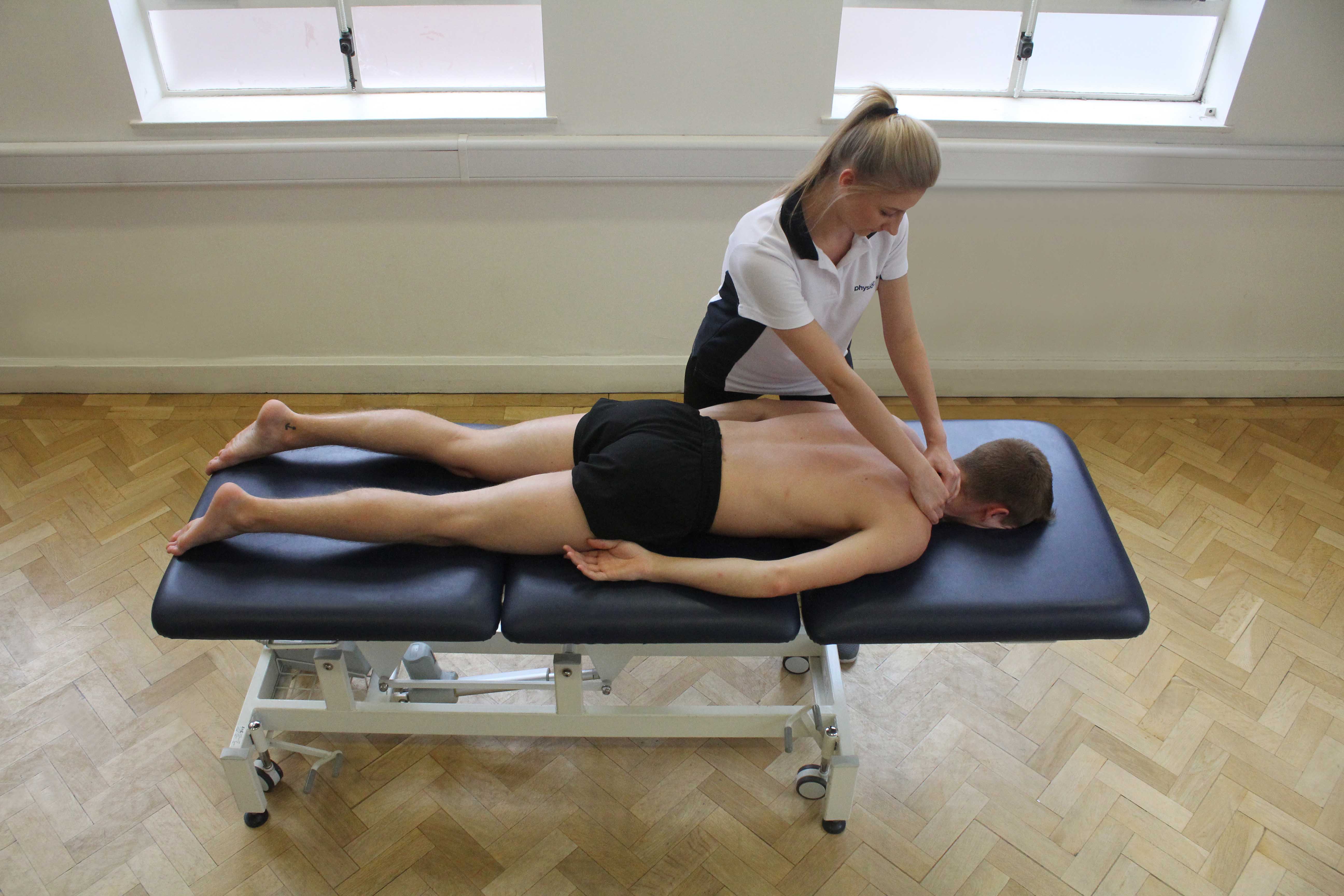 Above: deep tissue massage of trapezius muscle
Above: deep tissue massage of trapezius muscle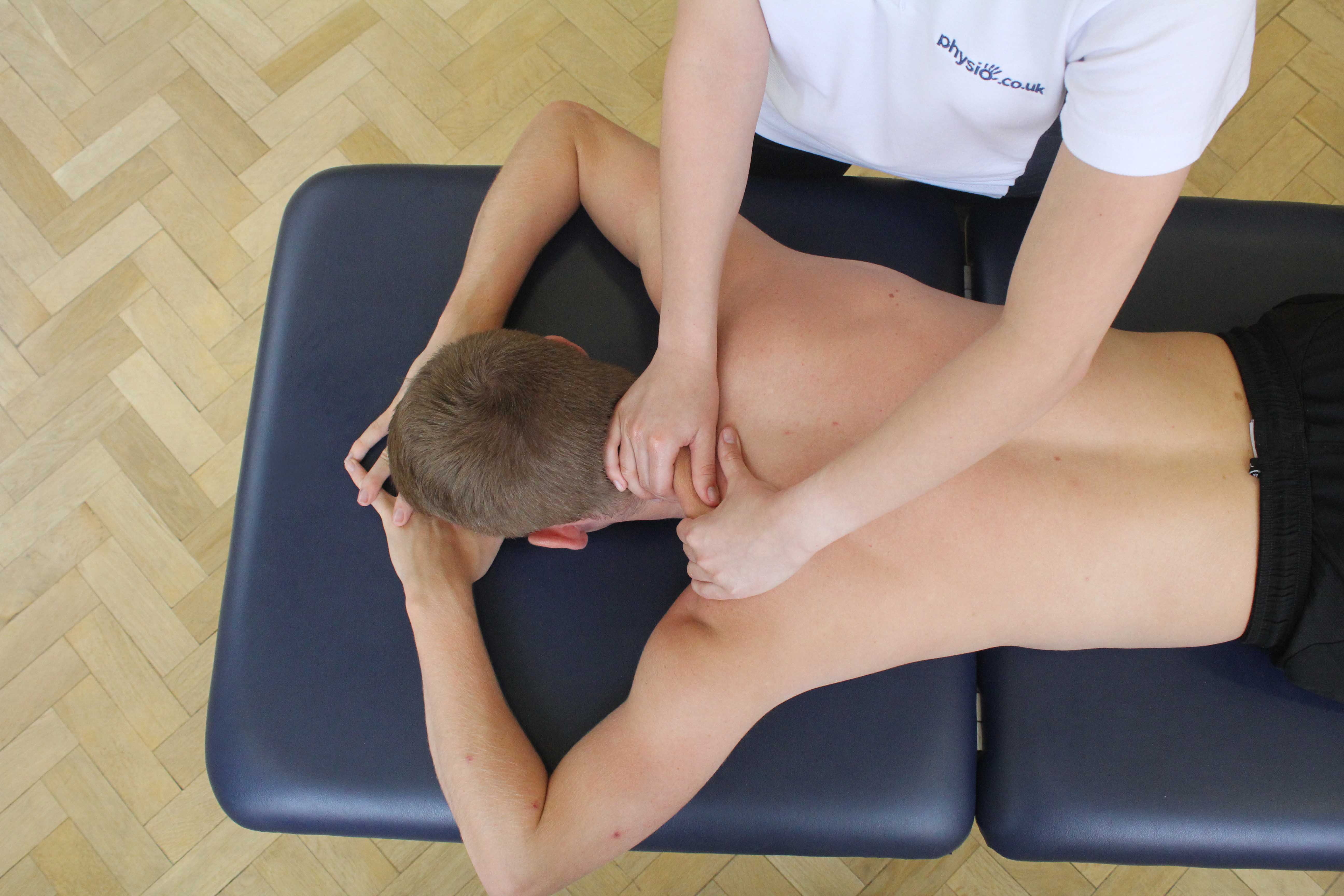 Above: Deep tissue massage to trapezius muscle
Above: Deep tissue massage to trapezius muscleHow does a neck massage decrease tension?
Decreased tension is a benefit often gained through neck massage. Tension is caused by muscle fibres that stay in the state of contraction and are unable to relax, resulting in a build-up of muscular fatigue and ache.
A neck massage aims to reduce tension by encouraging an increase in muscular relaxation.
During a neck massage, friction increases muscle temperature. An increase in temperature improves elasticity of muscular tissues. When tissue elasticity is poor, movement is restricted and tension increases. Improving tissue elasticity allows muscle fibres to relax and movement to increase. As muscle fibres relax and loosen, firmer massage strokes can be used to get deeper within the muscle fibres, increasing relaxation of the deeper tissue layers. Getting deeper with muscular tissues, further increases tissue elasticity and relieves tension. Relieving tension increases range of movement and reduces pain.
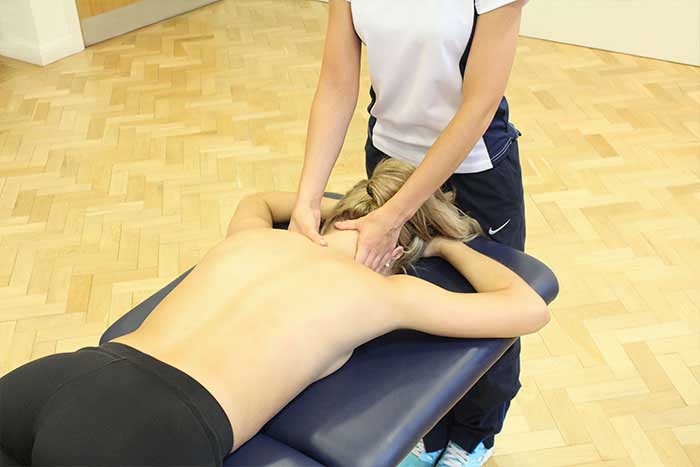
How does a neck massage reduce stress?
A neck massage is commonly used to help reduce stress. A person can experience both physical and mental stress.
A neck massage helps to reduce stress by encouraging muscle relaxation and reducing the level of cortisol.
When muscles are overused, this can put a lot of stress within the muscles causing muscles to fatigue and weaken. Fatigued and weakened muscles make injuries more likely to occur and can increase pain. A neck massage reduces stress within muscles by increasing blood flow. An increase in blood flow occurs due to the dilation of blood vessels or vasodilation. When vasodilation occurs, an increase in blood is able to flow through the vessels, increasing the availability of oxygen and nutrients for the muscles. Oxygen and nutrients are essential for the repair of damaged muscles and the maintenance of healthy muscles. Increasing availability of oxygen and nutrients increases healing and decreases muscular fatigue and weakness. Reducing fatigue and weakness within muscles reduces physical stress.
Cortisol is a negative hormone that is released in response to factors such as pain. Cortisol is a negative hormone known for increasing symptoms of stress, anxiety and depression. When pain occurs, cortisol is released further increasing pain. As pain increases so do cortisol levels, further increasing stress levels. A neck massage encourages the release of positive hormones to be circulated around the body and cortisol to be reduced. When more positive hormones are released, feelings of relaxation are increased whilst symptoms of stress are reduced. Decreasing cortisol helps to reduce mental stress.
How does a neck massage improve sensation?
A neck massage can help to improve sensation. Poor sensations can include numbness, pins and needles, tingling or pain. Poor sensations can be a result of injury or nerve compression.
A neck massage can improve sensation by relieving nerve compression.
Nerves are what give us all of our feelings. Nerves can create both positive feelings such as relaxation and negative feelings including pain. When nerves are compressed, this causes irritation. In response to the compression, the nerve endings will create negative sensations to make the body aware that something is not right. Nerves can produce numbness, shooting pains, tingling or pins and needles as this response. A neck massage relieves nerve compression by reducing joint stiffness and relieving tension. An increase in temperature occurs during a neck massage due to an improvement in blood flow. As temperature rises, joint stiffness reduces and muscle tension is reduced. A reduction in joint stiffness and muscular tension encourages the release of compressed nerves and therefore an improvement in sensation.
Summary
A neck massage concentrates on the sternocleidomastoid, scalene and upper trapezius muscles that make up the neck and shoulder area. A range of techniques including acupressure, mobilisations and skin rolling are used to help reduce acute pain, increase relaxation and relieve tight muscles. A range of benefits can be gained during a neck massage including decreased tension, reduced stress and improved sensation. Our massage therapists at Physio.co.uk use neck massage to help increase flexibility, maintain healthy muscles and improve circulation.
How can I arrange a neck massage?
The easiest way to arrange a neck massage at Physio.co.uk is to email us at office@physio.co.uk or call us on 0330 088 7800.
Alternatively if you have any questions please feel free to contact us.
We offer a 7 day service and provide home and clinic appointments.

 0330 088 7800
0330 088 7800



































